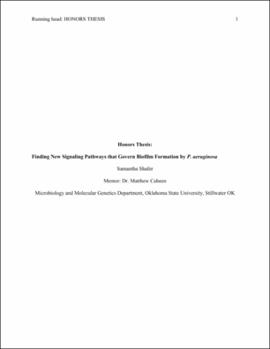| dc.description.abstract | Pseudomonas aeruginosa is an opportunistic pathogen that is often associated with severe forms of many infections, including bronchiectasis and infections in the gut. Mortality is increased in patients who become infected with P. aeruginosa. P. aeruginosa poses a special treatment challenge due to its propensity to form biofilms, in which cells are surrounded by a self-produced extracellular matrix of proteins, DNA, and polysaccharides. Biofilms can help bacteria evade the host immune response, and the matrix represents a barrier that protects bacteria against antibiotic therapy. Because biofilms are difficult to treat once established in an infection, new strategies to prevent biofilm formation are critical to combat these infections. However, effective prevention depends on a fuller understanding of the signaling pathways that control biofilm formation. To identify new control points in the pathways governing biofilm formation by P. aeruginosa, we use transposon mutagenesis in conjunction with a visual assay for colony morphology, in which colony wrinkling indicates biofilm formation. Using these screens, we have been able to identify many promising candidates. For example, we have identified mutations in the genes fdnG and PA14_42090 as having smoother colony morphology, suggesting that these genes are involved in biofilm formation. Conversely, we have found that mutations in the purU2 and trxB1 genes show increased colony wrinkling, suggesting that these genes normally suppress biofilm formation. We will continue characterizing these genes by deleting them from the genome to confirm their roles in biofilm production and then testing how their absence or presence affects other known biofilm signaling molecules such as cyclic-di-GMP. Our detailed characterization of these candidate genes will provide fundamental knowledge that can then be used to devise future treatments to prevent biofilm formation in patients infected with P. aeruginosa. | |
